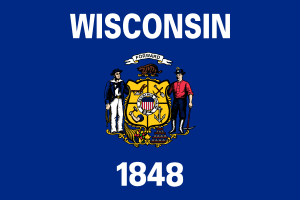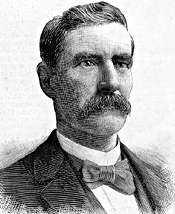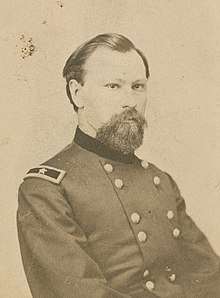6th Wisconsin Volunteer Infantry Regiment
The 6th Regiment Wisconsin Volunteer Infantry was an infantry regiment that served in the Union Army during the American Civil War. It spent most of the war as a part of the famous Iron Brigade in the Army of the Potomac.
| 6th Regiment Wisconsin Volunteer Infantry | |
|---|---|
 Wisconsin flag | |
| Active | July 16, 1861, to July 2, 1865 |
| Country | United States |
| Allegiance | Union |
| Branch | Infantry |
| Engagements | Battle of Second Bull Run Battle of South Mountain Battle of Antietam Battle of Chancellorsville Battle of Gettysburg Battle of the Wilderness Battle of Spotsylvania Court House Battle of Cold Harbor Siege of Petersburg Battle of Weldon Railroad Battle of Five Forks |
Service
The 6th Wisconsin was raised at Madison, Wisconsin, and mustered into Federal service July 16, 1861, for a term of three years. It saw severe fighting in the 1862 Northern Virginia Campaign, fighting at Brawner's Farm during the early part of the Second Battle of Bull Run. During the subsequent Maryland Campaign, the 6th attacked Turner's Gap in the Battle of South Mountain, and then suffered considerable casualties battling Hood's Texas Brigade in the D.R. Miller cornfield at Antietam.

During the first day of the Battle of Gettysburg on July 1, 1863, Lt. Col. Rufus R. Dawes led a counterattack on Joseph R. Davis's Confederate brigade of Mississippians, many of which were sheltered in an unfinished railroad cut west of town. The 6th forced the surrender of over 200 enemy soldiers. The regiment later served that year in the Bristoe and Mine Run Campaigns.
The regiment participated in the Grand Review of the Armies on May 23, 1865, and then mustered out at Louisville, Kentucky, on July 2, 1865.
Total enlistments and casualties
The 6th Wisconsin Infantry initially mustered 1,029 men and later recruited an additional 601 men, for a total of 1,630 men.[1] The regiment lost 16 officers and 228 enlisted men killed in action or who later died of their wounds, plus another 1 officer and 112 enlisted men who died of disease, for a total of 357 fatalities.[2]
Colonels
- Colonel Lysander Cutler - May 28, 1861, to November 29, 1862 - promoted to brigadier general.
- Colonel Edward S. Bragg - March 10, 1863, to June 25, 1864 - promoted to brigadier general.
- Colonel John Azor Kellogg - December 10, 1864, to July 14, 1865 - mustered out.
Notable people
 Lt Col Rufus Robinson Dawes
Lt Col Rufus Robinson Dawes John J. Jenkins
John J. Jenkins Benjamin J. Sweet
Benjamin J. Sweet
- Rufus Dawes - served as a lieutenant colonel - US congressman, father of vice president Charles G. Dawes
- Daniel J. Dill - served as a captain - politician
- John C. Hall - served as a regiment surgeon - physician and politician
- John J. Jenkins - served as a private - politician and jurist (Congressman)
- Robert Lees - served as private - politician
- James R. Lyon - served as a private - politician
- Adam Gale Malloy - served as a captain - was later brevetted brigadier general
- George Davis McDill - served as a private and corporal - politician
- Thomas McDill - served as a first lieutenant and captain - politician
- David K. Noyes - served as a first lieutenant and captain - politician, was later a lieutenant colonel
- Benjamin Sweet - served as a major and lieutenant colonel - politician, was later brevetted brigadier general
- John Tester - served as a first lieutenant - was later a businessman and politician
References
- The Civil War Archive
- Herdegen, Lance J., "Those Damned Black Hats!" The Iron Brigade in the Gettysburg Campaign, Savas Beatie LLC, October 2008. http://www.savasbeatie.com
- Service with the Sixth Wisconsin Volunteers (1890) at the Internet Archive
Notes
- 6th Wisconsin Archived March 26, 2007, at the Wayback Machine
- Civil War Archive